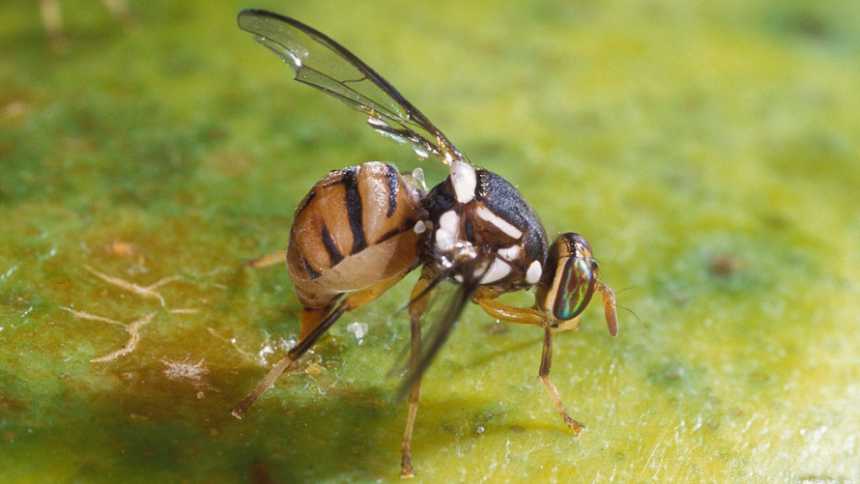Parts of Central California on Alert for Oriental Fruit Fly Menace

Here’s a closeup of the Oriental Fruit Fly. Portions of two counties in Central California were placed under quarantine after recent detections of the invasive pest. Photo by Scott Bauer
Portions of Contra Costa and Santa Clara counties in California have been placed under quarantine for the Oriental Fruit Fly following the detection of multiple flies in each county.
In Contra Costa County, detections near the cities of Brentwood and Oakley have resulted in a quarantine zone covering 99 square miles, bordered on the north by the San Joaquin River; on the south by Marsh Creek State Park; on the west by Black Diamond Mines Regional Preserve; and on the east side by the Old River.
In Santa Clara County, detections in the cities of Santa Clara and Sunnyvale have resulted in a quarantine zone covering 112 square miles, bordered on the north by Coyote Creek; on the south by Saratoga; on the west by Mountain View; and on the east by Alum Rock. A link to the quarantine maps can be found at cdfa.ca.gov/plant/off/regulation.html.
“Invasive fruit flies are serious pests for California’s orchards and backyard gardens,” says CDFA Secretary Karen Ross. “These recent detections remind us that we need to remain vigilant in protecting our food supply and natural resources. The stakes are enormous, and not just in California. A new report from the United Nations notes that invasive species management costs hundreds of billions of dollars each year around the world. We’re all in this together as we work to reduce this impact. ”
The Oriental Fruit Fly is known to target more than 230 different fruit, vegetable, and plant commodities. Important California crops at risk include grapes, pome, stone fruits, citrus, dates, avocados, and many vegetables, particularly tomatoes and peppers. Damage occurs when the female fruit fly lays eggs inside the fruit. The eggs hatch into maggots, which tunnel through the flesh of the fruit or vegetable, making it unfit for consumption.
RELATED CONTENT: Quarantine Zone Expands in Southern California for More Exotic Fruit Fly Finds
Following the principles of integrated pest management (IPM), agricultural officials use “male attractant” technique as the mainstay of the eradication effort for this invasive species. This approach has successfully eliminated dozens of fruit fly infestations in California. Trained workers treat a small patch of fruit fly attractant mixed with a very small dose of an organic pesticide, Spinosad, approximately 8-10 feet off the ground on street trees and similar surfaces; male fruit flies are attracted to the mixture and perish after consuming it. The male attractant treatment program is being carried out over an area that extends 1.5 miles from each site where the oriental fruit flies were trapped.
The most common pathway for these pests to enter the state is by “hitchhiking” in fruits and vegetables brought back illegally by travelers as they return from infested regions of the world or from packages of home grown produce from other countries sent to California.
The Oriental Fruit Fly is widespread throughout much of the mainland of southern Asia and neighboring islands, including Sri Lanka and Taiwan, and it has infested other areas, most notably Africa and Hawaii.
Additional information may be found here: cdfa.ca.gov/plant/off.









